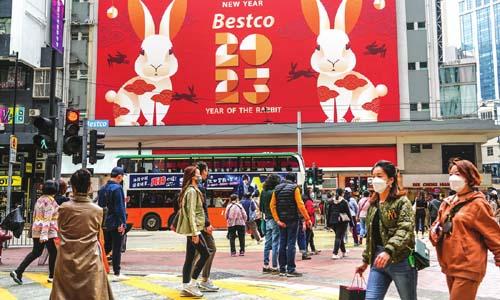
HK moves toward brighter future with determination
Global Times
Starting from Monday, normal travel between Hong Kong and the Chinese mainland will fully resume, and all boundary control points will open up without any prescribed daily numbers of people. All parts of the Hong Kong society have long awaited this day. In the past few years, Hong Kong has had a difficult time: It faced the impact of the epidemic of the century shortly after the turbulence over the amendment bill in the city in 2019. As a result, Hong Kong and the mainland had to implement a three-year-long border closure because of the COVID-19 epidemic prevention and control measures. With the changes of the anti-COVID policies, Hong Kong and the mainland now can finally see a full border reopening. This will not only inject more energy into the city’s economy, but also enable Hong Kong to use its unique advantage as a “super connector” between China and the rest of the world.
Various data immediately gave a positive response. The number of single-day passenger round-trip flights from the Chinese mainland to and from Hong Kong and Macao has increased to 130, while the number of single-day passenger flights in one month has increased by 171 percent month-on-month. The latest report from the S&P Global shows that Hong Kong’s Purchasing Managers’ Index rose to 51.2 in January, the first expansion since August 2022. The growth rate of new orders has been at its highest since July 2022. Local companies’ confidence in their businesses rose to a record high as enterprises look forward to a positive economic future. One cannot fail to live up to such expectations and confidence, and this also provides a deep motivation for the Government of the Hong Kong Special Administrative Region (HKSAR) to focus on developing the economy while creating a positive public opinion environment for it.

In recent days, the HKSAR government has launched a series of grand measures to welcome the return to normalcy. This includes the launch of the “Hello Hong Kong” campaign, which plans to give 700,000 free airline tickets to tourists around the world. This is probably the world’s largest initiative to attract tourists and is expected to attract more than 1.5 million visitors from the mainland as well as from other countries and regions. John Lee Ka-chiu, chief executive of the HKSAR government, is heading a delegation to Saudi Arabia and then to the United Arab Emirates, aiming to make use of the 10th launch anniversary of the China-proposed Belt and Road Initiative to strengthen trade, investment, and cultural exchanges between Hong Kong and the two countries. The initiative and enthusiasm shown by the HKSAR government clearly have a leading effect on Hong Kong society.
“The roads are connected, the people are connected, and the wealth is connected.” Full customs clearance means that Hong Kong has come out of the worst period of the epidemic and started a new stage to focus on recovering tourism and reviving the economy. Compared with 2019, Hong Kong has undergone many new changes in the past three years. Not only does it have new landmark attractions such as the Hong Kong Palace Museum and the M+, but more importantly, the Hong Kong National Security Law has been implemented, the electoral system has been improved, and the rule of law, civilization and order have basically been restored. Today’s Hong Kong is no longer the Hong Kong where anti-China rioters acted recklessly, nor is it a place where college and high school students cannot study at ease for fear their campuses may be attacked by thugs, nor is it a place where mainland tourists dare not speak Putonghua openly. Hong Kong, where order has been restored, is ushering in a critical period of development and is set to thrive.
What needs to be stressed is that all this will not happen automatically, and there may not even be smooth sailing. All sectors in Hong Kong need to come together with a united purpose, seize the “window of opportunity” and strive for new and greater development. It is undeniable that Hong Kong currently faces a more complex and volatile external environment. Although the anti-China forces have been suppressed, they have not disappeared. They are still infiltrating, disrupting and destroying Hong Kong in various ways such as “soft confrontation.” The US and the UK have not given up their plots and actions “to use Hong Kong to contain China.” But as they were unable to prevent the stability and prosperity of Hong Kong in the past, they will not do so today and in the future. What will greet them will be one humiliating defeat after another.
For Hong Kong, it is necessary to remain not only optimistic about the future, but also sober and calm about the reality. It has to overcome unfavorable factors, consolidate existing advantages, and keep advancing with the times. On the one hand, Hong Kong is still the original Hong Kong, adhering to the position of free trade port and relevant policies. On the other hand, Hong Kong is playing the role of “what the country needs and what Hong Kong is good at.” It is more actively aligning with the national development strategy, further integrating into the construction of the Guangdong-Hong Kong-Macao Greater Bay Area, actively participating in the domestic economic cycle, expanding development opportunities in the mainland, and relying on the global economic cycle and the Belt and Road Initiative for high-quality development to enhance export competitiveness. As long as Hong Kong moves forward firmly like this, it will only get better with a bright future in store.
